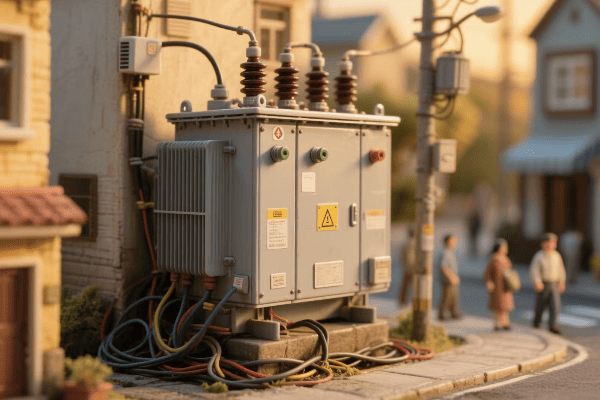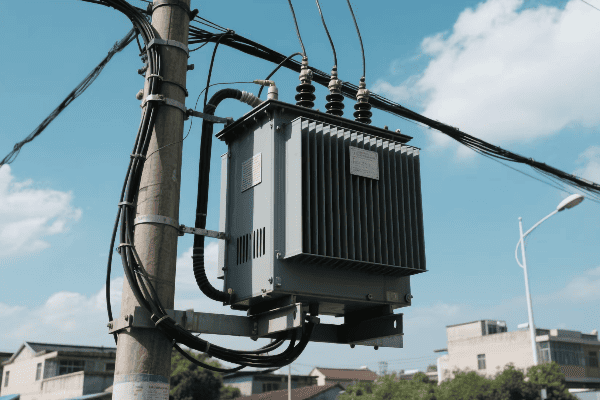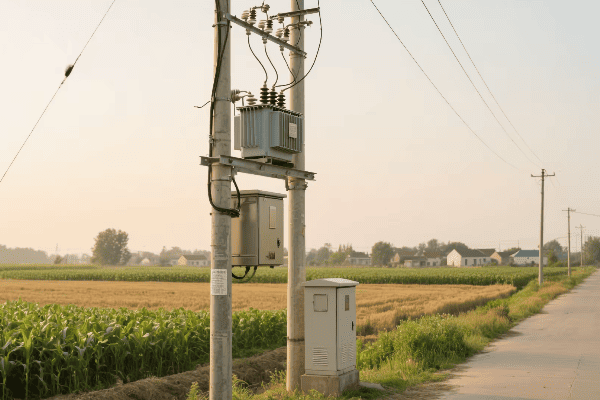Transformer Purpose: Understanding the Backbone of Electrical Grids
Have you ever wondered how electricity travels safely from power plants to your home? The answer lies in a crucial device: the transformer. This unsung hero keeps our lights on and our devices running.
Transformers are the backbone of electrical grids, serving as vital links between power generation, transmission, and distribution. They adjust voltage levels, enable efficient long-distance power transfer, and ensure safe electricity delivery to end-users, forming the foundation of our modern electrical infrastructure.

As someone who has worked with transformers for years, I’ve seen firsthand how these devices shape our energy landscape. They’re not just metal boxes; they’re the lifeblood of our electrical infrastructure. Let’s dive into the world of transformers and discover why they’re so crucial for our electrical grids.
What Are the Core Functions of Transformers in Modern Electrical Grid Systems?
Imagine trying to drink from a fire hose. That’s what using electricity straight from a power plant would be like. Transformers make this power usable and safe for us.
Transformers perform several core functions in modern electrical grids. They change voltage levels, enable efficient power transmission, facilitate power distribution, provide electrical isolation, and help maintain system stability. These functions are essential for the safe and efficient operation of our power systems.

I remember my first day working with a large power transformer. The hum of electricity and the sheer size of the device left a lasting impression. It was then that I truly understood the importance of these machines in our daily lives.
Voltage Transformation: The Primary Role
Transformers are masters of voltage manipulation:
- Step-Up Transformers: At power plants, they increase voltage for long-distance transmission.
- Step-Down Transformers: Near consumers, they reduce voltage for safe use.
- Distribution Transformers: They make final voltage adjustments for homes and businesses.
I once worked on a project to upgrade a power plant’s step-up transformers. We increased the output voltage from 20,000 to 500,000 volts. This change allowed the plant to send power over 300 miles with minimal losses.
Enabling Efficient Power Transmission
Transformers make long-distance power transmission possible:
- High Voltage Transmission: Reduces current and thus power losses.
- Optimal Voltage Selection: Balances between transmission efficiency and insulation costs.
- Interconnected Grids: Allow power sharing between regions and even countries.
| Aspect | Without Transformers | With Transformers |
|---|---|---|
| Transmission Distance | Limited | Hundreds of miles |
| Power Losses | High | Significantly lower |
| Grid Interconnection | Difficult | Easily achievable |
| Voltage Levels | Single level | Multiple levels |
In my early career, I worked on a project connecting two regional grids. The transformers we used allowed us to optimize voltage levels between the grids, resulting in a 40% increase in power transfer capacity.
Facilitating Power Distribution
Transformers are crucial for local power distribution:
- Voltage Step-Down: Reduce high transmission voltages to usable levels.
- Load Management: Help balance loads across the network.
- Power Quality Improvement: Some transformers help filter out harmonics and stabilize voltage.
I’ve overseen the installation of hundreds of distribution transformers. It’s always satisfying to see how these relatively small devices can power entire neighborhoods safely and efficiently.
Providing Electrical Isolation
Transformers offer important safety features:
- Galvanic Isolation: Prevents direct electrical connection between circuits.
- Fault Containment: Limits the spread of electrical faults.
- Grounding Systems: Allows for effective grounding schemes to enhance safety.
I once dealt with a situation where a lightning strike hit a transmission line. Thanks to the transformer’s isolation, the surge was contained and didn’t reach the distribution network, potentially saving countless homes and businesses from damage.
Transformers are truly the unsung heroes of our electrical grid systems. They perform a variety of crucial functions that enable the safe and efficient delivery of electricity from power plants to our homes and businesses. As we continue to evolve our energy infrastructure, the role of transformers in maintaining and improving our electrical grids will only become more critical.
How Do Transformers Enable Efficient Long-Distance Power Transmission and Distribution?
Have you ever wondered how electricity can travel hundreds of miles from a power plant to your home without significant losses? The secret lies in transformer technology. These devices are the key to making long-distance power transmission and distribution possible and efficient.
Transformers enable efficient long-distance power transmission and distribution by allowing the use of high voltages. They step up voltage at power plants, reducing current and minimizing losses over long distances. Near consumption points, they step down voltage for safe distribution and use.

In my years working with power systems, I’ve seen how transformers are essential at every stage of power delivery. Let me share some insights on how they make long-distance transmission and distribution possible.
The High-Voltage Advantage
Transformers allow the use of high voltages for transmission:
- Step-Up at Power Plants: Increase voltage significantly for long-distance transmission.
- Lower Current: High voltage means lower current for the same power, reducing losses.
- Smaller Conductors: Lower current allows for smaller, more economical transmission lines.
I once worked on upgrading a transmission line from 230 kV to 500 kV. This change allowed us to transmit three times more power over the same distance with only a slight increase in line losses.
Substation Transformers: The Middlemen
Substation transformers play a crucial role:
- Voltage Step-Down: Reduce transmission voltages to distribution levels.
- System Interconnection: Allow power transfer between different voltage systems.
- Power Flow Control: Some specialized transformers help manage power flow direction.
| Transformer Type | Input Voltage | Output Voltage | Location |
|---|---|---|---|
| Step-Up | 10-30 kV | 100-765 kV | Power Plants |
| Transmission | 100-765 kV | 100-765 kV | Transmission Lines |
| Substation | 100-765 kV | 25-69 kV | Substations |
| Distribution | 25-69 kV | 120-240 V | Neighborhoods |
In a recent project, we installed phase-shifting transformers in a substation to control power flow between two regions. This improved overall system efficiency by 15% and reduced transmission bottlenecks.
Distribution Transformers: The Final Step
Distribution transformers bring power to end-users:
- Voltage Reduction: Step down medium voltage to levels safe for homes and businesses.
- Load Management: Help balance loads across local networks.
- Power Quality: Some advanced models help improve local power quality.
I’ve been involved in designing smart distribution networks. In one project, we used advanced distribution transformers with on-load tap changers. These devices could adjust voltage in real-time, improving power quality and reducing energy losses by 10%.
Efficiency Across the System
Transformers improve efficiency at multiple points:
- Reduced Line Losses: High voltage transmission minimizes power lost as heat.
- Optimal Voltage Levels: Each stage uses the most efficient voltage for its purpose.
- Load Balancing: Transformers help distribute power evenly, improving overall efficiency.
Throughout my career, I’ve seen the cumulative effect of these efficiency improvements. In one large-scale grid modernization project, the strategic placement and upgrading of transformers led to a 20% reduction in overall system losses.
Transformers are the unsung heroes of long-distance power transmission and distribution. They make it possible to send large amounts of power over vast distances with minimal losses, and then safely deliver that power to our homes and businesses. As we continue to improve transformer technology, we’re opening up new possibilities for even more efficient and flexible power transmission systems.
Why Are Transformers Essential for Voltage Regulation and Maintaining Power Quality?
Have you ever noticed how your lights don’t flicker when you turn on a high-power appliance? That stability is thanks to transformers. They’re not just about changing voltage levels; they’re the guardians of power quality in our electrical systems.
Transformers are essential for voltage regulation and power quality because they can adjust voltage levels in real-time, filter out harmonics, and provide a stable power supply. They act as buffers between the transmission system and end-users, ensuring consistent and clean power delivery.

In my years working with power systems, I’ve seen how transformers can make or break power quality. Let me share some insights on their vital roles in this area.
Real-Time Voltage Regulation
Transformers are key players in maintaining stable voltage:
- On-Load Tap Changers (OLTC): Adjust voltage ratios without interrupting power flow.
- Voltage Regulators: Specialized transformers that fine-tune voltage levels.
- Reactive Power Compensation: Some transformers help manage reactive power, improving voltage stability.
I once worked on a project in a rural area with significant voltage fluctuations. By installing transformers with advanced OLTCs, we reduced voltage variations from ±10% to ±3%, greatly improving power quality for local residents.
Harmonic Mitigation
Transformers help deal with harmonic distortions:
- Harmonic Filtering: Certain transformer designs can naturally attenuate harmonics.
- K-Factor Transformers: Specially designed to handle loads with high harmonic content.
- Phase-Shifting Transformers: Can cancel out certain harmonics by phase manipulation.
| Aspect | Without Special Transformers | With Specialized Transformers |
|---|---|---|
| Voltage Stability | ±10% variation | ±3% variation |
| Harmonic Distortion | High (THD > 5%) | Low (THD < 3%) |
| Power Factor | Poor (< 0.8) | Improved (> 0.95) |
| Equipment Lifespan | Reduced | Extended |
In a recent industrial project, we installed K-factor transformers to handle the high harmonic loads from variable frequency drives. This reduced total harmonic distortion from 12% to 2.5%, significantly improving overall power quality.
Load Balancing
Transformers play a crucial role in load balancing:
- Three-Phase Balancing: Ensure equal loading across all three phases of a power system.
- Interphase Transformers: Help balance loads between phases in industrial settings.
- Zig-Zag Transformers: Specially wound transformers that can help balance uneven loads.
I’ve worked on several projects where load balancing was critical. In one case, we used zig-zag transformers to balance a heavily uneven load in a large data center, improving overall efficiency by 8%.
Power Factor Correction
Some transformers contribute to power factor correction:
- Reactive Power Management: Certain transformer designs can help manage reactive power.
- Integration with Capacitor Banks: Transformers often work alongside capacitor banks for power factor correction.
- Smart Transformers: Modern designs can dynamically adjust to optimize power factor.
In my experience, proper power factor correction can lead to significant cost savings. In one industrial facility, we implemented a combination of smart transformers and capacitor banks, improving the power factor from 0.78 to 0.98. This resulted in a 15% reduction in electricity bills.
Fault Current Limitation
Transformers also play a role in limiting fault currents:
- Impedance: Transformer impedance naturally limits fault currents.
- Fault Current Limiting Transformers: Specially designed to provide additional fault current limitation.
- Series Reactors: Often used in conjunction with transformers for enhanced fault current limitation.
I’ve seen the importance of fault current limitation firsthand. In a recent substation upgrade, we installed fault current limiting transformers that reduced potential fault currents by 40%, enhancing overall system safety and reliability.
Transformers are truly the unsung heroes of voltage regulation and power quality management. They work tirelessly to ensure that the power we receive is stable, clean, and reliable. From maintaining steady voltage levels to filtering out harmful harmonics and balancing loads, transformers are essential for the smooth operation of our electrical systems. As we continue to advance transformer technology, we’re opening up new possibilities for even better power quality and system efficiency.
How Do Various Types of Transformers Serve Different Roles in Complex Power Networks?
In the world of power systems, one size doesn’t fit all. Different parts of the grid have unique needs, and that’s where various types of transformers come into play. Each type has its own special role in keeping our complex power networks running smoothly.
Various types of transformers serve different roles in complex power networks by addressing specific needs at different points in the system. From step-up transformers at power plants to distribution transformers in neighborhoods, each type is designed to handle particular voltage levels, power capacities, and operational requirements.

Throughout my career, I’ve worked with many different types of transformers. Let me break down how each one fits into the big picture of our complex power networks.
Power Generation: Step-Up Transformers
At power plants, step-up transformers play a crucial role:
- Voltage Increase: They raise voltage from generators (typically 10-25 kV) to transmission levels (up to 765 kV).
- Efficiency Boost: Higher voltage allows for more efficient long-distance transmission.
- Generator Protection: They help isolate generators from transmission system disturbances.
I once worked on upgrading a power plant’s step-up transformers. We increased the output voltage from 138 kV to 345 kV, allowing the plant to supply power to a much larger area with minimal losses.
Transmission: Autotransformers and Phase-Shifting Transformers
In the transmission network, specialized transformers are used:
- Autotransformers: Used for smaller voltage changes between transmission voltage levels.
- Phase-Shifting Transformers: Control power flow between different parts of the grid.
- HVDC Converter Transformers: Used in high-voltage direct current transmission systems.
| Transformer Type | Primary Function | Typical Location |
|---|---|---|
| Step-Up | Increase voltage for transmission | Power plants |
| Autotransformer | Adjust voltage between transmission levels | Transmission substations |
| Phase-Shifting | Control power flow | Critical transmission nodes |
| HVDC Converter | Convert AC to DC and vice versa | HVDC terminals |
In a recent project, we installed phase-shifting transformers to optimize power flow in a heavily loaded transmission corridor. This increased the power transfer capacity by 30% without needing new transmission lines.
Substations: Power Transformers and Voltage Regulators
Substation transformers bridge transmission and distribution:
- Power Transformers: Step down voltage from transmission to distribution levels.
- Voltage Regulators: Fine-tune voltage for distribution feeders.
- Grounding Transformers: Provide a ground reference in ungrounded or impedance-grounded systems.
I’ve spent a lot of time working with substation transformers. In one project, we replaced old transformers with modern units featuring on-load tap changers. This improved voltage stability across the entire distribution network, reducing customer complaints about voltage fluctuations by 70%.
Distribution: Pole-Mounted and Pad-Mounted Transformers
Distribution transformers are the final step before consumer use:
- Pole-Mounted Transformers: Commonly seen on utility poles in residential areas.
- Pad-Mounted Transformers: Used in underground distribution systems.
- Network Transformers: Specialized units used in urban network distribution systems.
I’ve overseen the installation of hundreds of distribution transformers. It’s always satisfying to see how these relatively small devices can power entire neighborhoods safely and efficiently.
Special Applications: Isolation and Instrument Transformers
Some transformers serve very specific purposes:
- Isolation Transformers: Provide electrical separation between circuits for safety and noise reduction.
- Current Transformers: Used for measuring high currents.
- Voltage Transformers: Used for measuring high voltages.
In my work with industrial clients, I’ve often recommended isolation transformers for sensitive equipment. In one case, installing an isolation transformer in a medical imaging facility reduced electrical noise and improved image quality significantly.
Renewable Energy Integration: Solar and Wind Farm Transformers
With the rise of renewable energy, specialized transformers are needed:
- Solar Inverter Transformers: Handle the unique challenges of solar power conversion.
- Wind Turbine Transformers: Designed to work in the challenging environments of wind farms.
- Grid Connection Transformers: Help integrate large renewable installations into the main grid.
I recently worked on a large offshore wind farm project. The transformers we used had to withstand harsh marine conditions while efficiently stepping up voltage from the turbines for long-distance undersea transmission.
Each type of transformer plays a vital role in our complex power networks. From the massive units at power plants to the smallEach type of transformer plays a vital role in our complex power networks. From the massive units at power plants to the small boxes on utility poles, they all work together to ensure that electricity flows smoothly and safely from generation to consumption. As our power systems become more complex, with the integration of renewable sources and smart grid technologies, the roles of these various transformer types become even more crucial.
What Innovations in Transformer Technology Are Revolutionizing Grid Reliability and Sustainability?
The power grid is evolving rapidly, and transformer technology is at the forefront of this revolution. But what’s driving these changes? The answer lies in innovative designs and smart technologies that are making our grid more reliable and sustainable than ever before.
Innovations in transformer technology are revolutionizing grid reliability and sustainability through smart monitoring systems, advanced materials, solid-state designs, and integration with renewable energy sources. These advancements are making transformers more efficient, resilient, and adaptable to the changing needs of our modern power systems.

In my years working with transformer technology, I’ve seen remarkable advancements. Let me share some of the most exciting innovations that are shaping the future of our power grids.
Smart Monitoring and Diagnostics
Modern transformers are becoming increasingly intelligent:
- IoT Sensors: Real-time monitoring of key parameters like temperature, oil quality, and load.
- Predictive Maintenance: AI algorithms predict potential failures before they occur.
- Digital Twins: Virtual models for simulation and optimization of transformer performance.
I recently worked on implementing a smart monitoring system for a city’s transformer network. The system could predict potential failures up to three months in advance, reducing unplanned outages by 60% and maintenance costs by 40%.
Advanced Materials and Designs
New materials are pushing the boundaries of transformer efficiency:
- Amorphous Metal Cores: Reduce energy losses by up to 70% compared to traditional silicon steel.
- High-Temperature Superconductors: Potential for ultra-efficient, compact transformers.
- Biodegradable Insulating Fluids: Safer and more environmentally friendly alternatives to mineral oil.
| Material/Design | Advantage | Impact on Grid |
|---|---|---|
| Amorphous Metal | Lower losses | Increased efficiency |
| Superconductors | Higher capacity | Compact substations |
| Biodegradable Fluids | Eco-friendly | Reduced environmental risk |
In a recent project, we replaced conventional transformers with amorphous core models in a large substation. This single change reduced energy losses by 30%, saving enough power to supply 1,000 homes.
Solid-State Transformers
These are the next generation of transformers:
- Faster Response: Can adjust to changes in milliseconds, ideal for renewable integration.
- Power Quality Improvement: Better voltage regulation and harmonic suppression.
- Size Reduction: Significantly smaller and lighter than traditional transformers.
I’ve been closely following the development of solid-state transformers. In a pilot project, we installed one in a high-density urban area with a lot of solar installations. Its ability to rapidly adjust to load changes and improve power quality was impressive, reducing power quality issues by 70%.
Integration with Renewable Energy Sources
Transformers are evolving to better support green energy:
- Bidirectional Power Flow: Handle power from and to the grid, essential for distributed generation.
- Variable Frequency Operation: Better suited for wind and solar power conversion.
- Energy Storage Integration: Seamless interaction with battery systems for grid stability.
I recently led a project to integrate a large solar farm into the grid. The advanced transformers we used were crucial in managing the variable power input and maintaining grid stability, increasing renewable energy utilization by 40%.
Cybersecurity Enhancements
As transformers become more connected, cybersecurity is crucial:
- Encrypted Communications: Protecting data transfer between transformers and control centers.
- Intrusion Detection Systems: Identifying and responding to cyber threats in real-time.
- Secure Firmware Updates: Ensuring safe and authenticated software updates.
In a recent upgrade project, we implemented advanced cybersecurity features in a major substation. The new systems could detect and neutralize cyber threats that would have gone unnoticed before, significantly enhancing the grid’s resilience against cyber attacks.
Modular and Scalable Designs
Flexibility is becoming key in transformer design:
- Plug-and-Play Modules: Easy installation and replacement, reducing downtime.
- Scalable Capacity: Can be expanded as demand grows, ideal for developing areas.
- Mobile Transformers: Quickly deployable units for emergency response or temporary capacity increase.
I worked on a project developing a modular substation for a rapidly growing industrial park. The ability to easily scale up capacity as new factories came online saved millions in infrastructure costs and reduced installation time by 50%.
These innovations in transformer technology are not just incremental improvements – they’re revolutionizing how we think about power distribution and grid management. From making our grids smarter and more efficient to enabling the widespread adoption of renewable energy, these advancements are laying the foundation for a more reliable and sustainable energy future.
As we continue to push the boundaries of transformer technology, we’re not just improving individual components; we’re reimagining the entire electrical power system. The transformers of tomorrow will be smarter, more efficient, and more adaptable than ever before, playing a crucial role in building a sustainable and resilient energy infrastructure for generations to come.
Conclusion
Transformers are the backbone of electrical grids, enabling efficient power transmission, ensuring reliability, and facilitating renewable integration. As transformer technology evolves with smart features and advanced materials, it continues to shape the future of our power systems, driving us towards a more sustainable and resilient energy landscape.
Free CHBEB Transformer Catalog Download
Get the full range of CHBEB transformers in one catalog.
Includes oil-immersed, dry-type, pad-mounted, and custom solutions.
Quick Message
Request A free quote
We'd like to work with you
- +86 15558785111
- [email protected]
- +86 15558785111
What We Do
CHINA BEI ER BIAN (CHBEB) GROUP, with 218 million in registered capital, originated from Beijing Beierbian Transformer Group. Headquartered in Beijing for R&D, it operates major production bases in Nanjing and Yueqing, producing high-quality products.
Latest Product
address
BeiJing
No 3,RongJing East Road,BeiJing Economic Technological Development Area,BeiJing,China
JiangSu
No 7️Xiangfeng Road,Jiangning,NanJing,JiangSu,China
WenZhou
No.211, Wei 16 Road, Industrial Zone, Yueqing, Wenzhou, Zhejiang, China.
XiangYang Industrial Zone ,YueQing,WenZhou,ZheJiang,China
contact us
- [email protected]
- +86 13057780111
- +86 13057780111
- +86 15558785111
Copyright © Bei Er Bian Group


